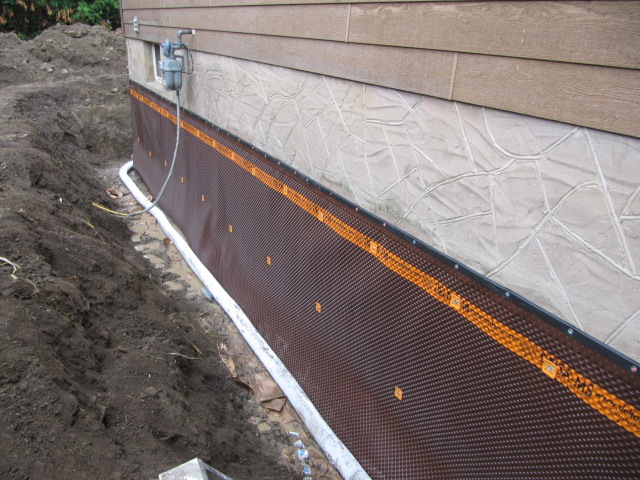A home’s foundation is its literal and figurative cornerstone, providing stability, support, and structural integrity. Yet, even the most solid foundation can face threats from water infiltration, which can lead to damage, deterioration, and costly repairs.
This is where weeping tiles come into play as unsung heroes of foundation protection. In this article, we will delve into the importance of weeping tiles as a part of basement waterproofing systems. How they work, their various types, and why they are a vital component of any home’s drainage system.
Before delving into their importance, let’s clarify what weeping tiles are. Contrary to what the name suggests, weeping tiles are not actual tiles but rather a system of pipes or tubes buried around the perimeter of a building’s foundation. They are designed to manage and redirect groundwater and rainwater away from the foundation, preventing moisture from seeping into the basement or crawl space.
How Weeping Tiles Work
The concept behind weeping tiles is relatively simple, yet highly effective.
Weeping tiles consist of a series of perforated pipes or tubes made from materials like PVC or corrugated plastic. These pipes are buried underground around the foundation, typically at the footing level.
When soil becomes saturated due to heavy rainfall or high groundwater levels, water naturally seeks the path of least resistance. In this case, it enters the perforations in the weeping tiles.
Weeping tiles rely on gravity and the natural slope of the ground to guide water away from the foundation. As water enters the perforations, it flows through the pipes and exits at a safe distance from the building. They help prevent hydrostatic pressure, which is the upward force exerted by water in the soil against the foundation walls. This pressure can lead to water infiltration, cracks in the foundation, and structural damage.
The Importance of Weeping Tiles
Weeping tiles are integral to the overall health and longevity of a building’s foundation. Here are several reasons why they are so crucial –
Preventing Basement Flooding – Weeping tiles are a primary defense against basement flooding. By directing excess water away from the foundation, they keep the basement dry, protecting valuable possessions and preventing water damage.
- Foundation Preservation – Excess moisture around the foundation can lead to cracks, efflorescence (white powdery deposits), and even foundation settlement. Weeping tiles play a pivotal role in preserving the integrity and stability of the foundation.
- Mold and Mildew Prevention – Moisture in the basement or crawl space creates a favorable environment for mold and mildew growth. Weeping tiles help maintain a dry foundation, reducing the risk of mold-related health issues.
- Increased Living Space – A dry, well-maintained basement can be transformed into additional living space, a recreation area, or a storage area. Weeping tiles facilitate this transformation by keeping the basement dry and habitable.
- Preventing Soil Erosion – Weeping tiles prevent soil erosion around the foundation, which can undermine the structural stability of the building. Proper drainage ensures that the soil remains in place, supporting the foundation.
- Protecting Property Value – A home with a well-maintained foundation and a dry basement is more appealing to buyers and retains its value over time. Weeping tiles contribute to the overall property value.
Types of Weeping Tiles
Weeping tiles come in different types to suit various needs and preferences. The two primary categories are –
Exterior Weeping Tiles – These are installed outside the foundation walls, typically along the footing. They are the most common type and effectively prevent water from reaching the foundation walls. Exterior weeping tiles require excavation around the foundation to install.
Interior Weeping Tiles – Interior weeping tiles are installed inside the basement or crawl space, adjacent to the foundation walls. They collect and redirect water that has already infiltrated the basement, helping to keep the interior dry. Interior weeping tiles do not require extensive excavation and are often used as a solution for existing homes.
Maintenance and Inspection
To ensure the continued effectiveness of weeping tiles, regular maintenance and inspections are essential.
Exterior weeping tiles can become clogged with debris over time. Clearing any obstructions, such as leaves or sediment, from the pipes and surrounding gravel is crucial.
You may also want to inspect the weeping tile system for damage or blockages. Look for signs of water seepage in the basement or crawl space, as this may indicate a problem with the weeping tiles. And if your weeping tiles are connected to a sump pump system, ensure that the pump is functioning correctly. Test it periodically to verify that it activates when needed.
Consider scheduling a professional inspection of your weeping tile system every few years. Experts can identify issues that may not be visible during a visual inspection.
Weeping tiles are a fundamental component of a home’s drainage system, safeguarding the foundation from the detrimental effects of water infiltration. They protect against basement flooding, preserve the structural integrity of the foundation, prevent the need for concrete repairs, and contribute to a dry and habitable living space. Whether you have an existing home or are building a new one, investing in weeping tiles is a wise choice to ensure the long-term health and stability of your property.

